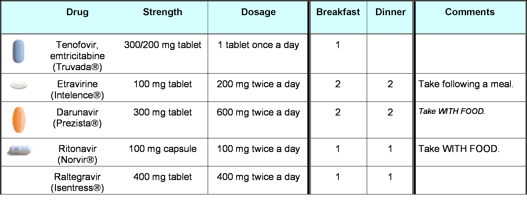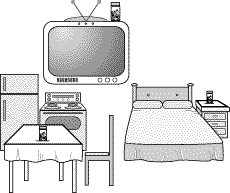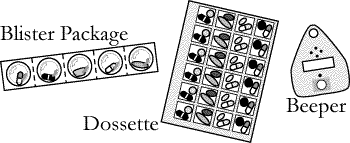What are some suggestions and tips to help make taking medications easier?
Prepare in Advance
Before starting antiretroviral therapy, you can prepare yourself in order to get the most benefit from your medications.
Some tips include:
Find out what dosing regimen you will be on, and practice taking candies or mints at regular times. If you find you are having trouble with your routine, you may want to try out some of the ideas listed later in this section to see which will best suit you.
Learn about possible temporary side effects of the medications, and make sure you have supplies on hand for relief (e.g., over-the-counter medications, palatable food, etc.).
Put support mechanisms in place in advance. Sometimes having a “buddy” (e.g., someone who can remind you to take your medications, help you if you are not feeling well, or give you tips on how to manage certain side effects) can be useful.
Create a Personal Schedule
Most people find it helpful to make a medication schedule that will fit into their daily routine.
Check to see that your bottles are clearly labeled with the name of the drug and the directions. Keep information leaflets on your medications that contain special instructions.
Make sure you know exactly when and how each drug should be taken (e.g., number of times each day, with or without food, number of pills).
Try to fit your dosing times into your daily routine,keeping in mind your normal waking and sleeping times, your meal times and other activities such as working or going out.
If possible, try to simplify the number of dosing times during the day, but always check with your pharmacist to make sure that your medications can be taken together.
You may wish to sketch out your schedule on a piece of paper. Make an appointment with the pharmacist if you would like help in creating your schedule. For example:
Medication Schedule Example – Twice Daily

Medication Schedule Example – Once Daily

Make sure your medications are always available
It may be helpful to keep your medications in a highly visible place such as on the kitchen table, by the television, beside your bed, or wherever you usually are at the times you need to take your medications.

You may also want to keep a small amount of your medications at work or at a friend’s place as a spare supply.
Plan ahead for trips and weekends. You may need to send a supply of medication to your destination in advance if you are traveling to another country.
Avoid letting your medication supply run low. Make appointments with your doctor for new prescriptions well in advance. Also, call your pharmacy for refills of your medications several days ahead of time.
Take advantage of compliance devices
The main reason people miss medication doses is that they simply FORGET. There are many devices available to help people remember to take their medications correctly. Ask your pharmacist which devices may be most suitable for your needs. Some commonly used compliance devices include:

Dossettes – Dossettes are plastic containers that organize doses of your medications. The containers are divided into sections for different times throughout the day (usually morning, afternoon, evening, and bedtime). Dossettes come in different sizes, and can hold a day’s or a week’s worth of medication at a time. Your medications are placed in each compartment according to when you need to take them. This also provides a visual reminder for you as you take your medications. If you think this option sounds helpful, you can ask your pharmacy to put your medications in dossettes on a weekly basis. Another option is for you to buy a dossette and fill it on your own. Remember that some drugs are sensitive to light, temperature, and/or moisture and should be kept in their original containers.
Blister packaging – Certain pharmacies will provide a service (often free of charge) called blister or bubble packing. Blister packs help to organize your doses of medication each day the same way that dossettes do. However, instead of plastic containers, blister packs are sealed cards that have clear plastic bubbles that hold doses of your medications. Usually, the bubbles on each card are divided into four columns labeled morning, noon, evening, and night, with a different row for each day of the week. You may need more than one card to fit all your medications. At each dosing time, you just push the medication(s) out through the back of the card. Some medications cannot be blister packed because they have to be stored in their original container. Ask your pharmacist for more information about this option if it appeals to you.
Medication Diary – Another way to keep track of your medications is to use a diary to record each dose that you take. If you find yourself missing a lot of doses, check your diary to see if there is a pattern. For instance, people often forget doses on weekends or holidays because they sleep in later or have their meals at different times. Others may miss doses because they are working or are out late at night. If you notice a pattern, try to rearrange your medication schedule so it will fit better into your daily routine.
Beepers – You can also ask your community pharmacist about beepers or alarms to remind you to take your medications at the proper times. Another method is to use an electronic watch with a beeper.

FAQ's Menu
- FAQ's
- Why take antiretrovirals?
- Why is it important to take medications regularly?
- Why do certain drugs have to be taken with food and others taken on an empty stomach?
- What if you have side effects?
- Should you lower your drug dose if you are having side effects?
- Is it safe to take antiretrovirals with other medications?
- Is it safe to use alcohol or recreational drugs while you are on antiretroviral therapy?
- Why should medications be stored under specific conditions?
- What are some suggestions and tips to help make taking medications easier?
- Who should you tell if you are having problems?
- How can you get support and encouragement?
- Credits

